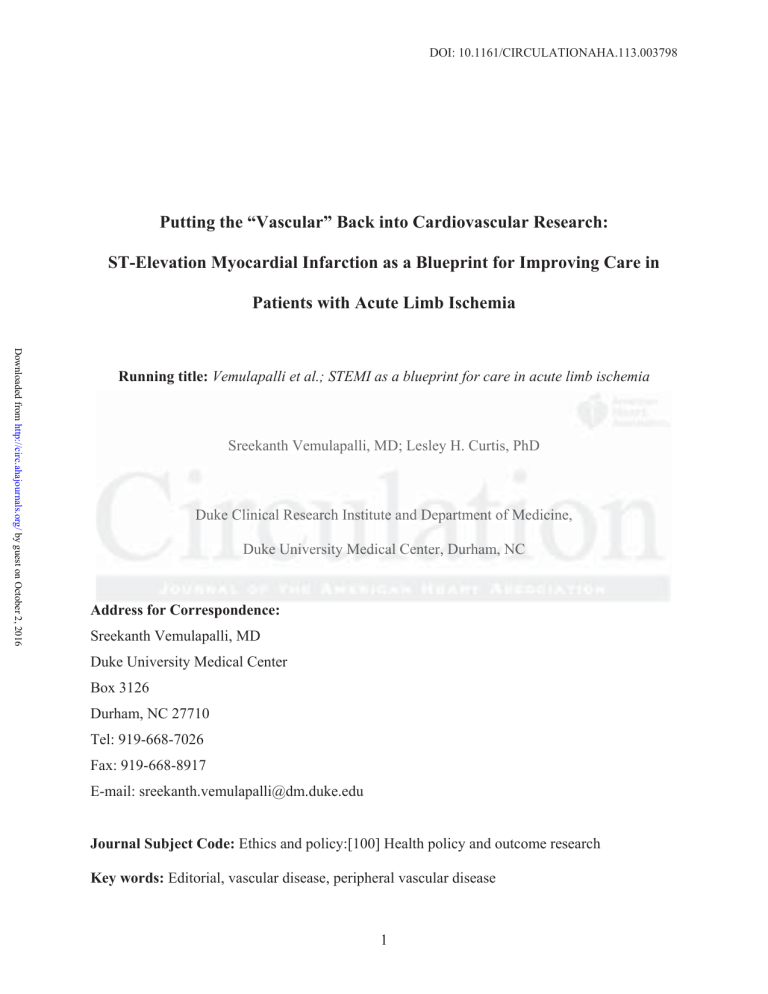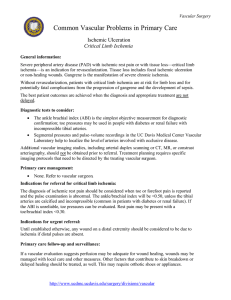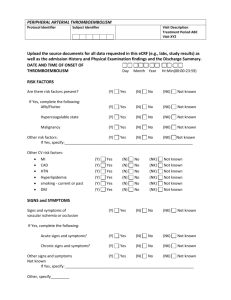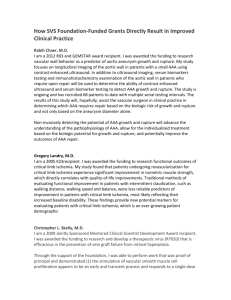
DOI: 10.1161/CIRCULATIONAHA.113.003798
Putting the “Vascular” Back into Cardiovascular Research:
ST-Elevation Myocardial Infarction as a Blueprint for Improving Care in
Patients with Acute Limb Ischemia
Downloaded from http://circ.ahajournals.org/ by guest on October 2, 2016
Running title: Vemulapalli et al.; STEMI as a blueprint for care in acute limb ischemia
Sreekanth Vemulapalli, MD; Lesley H. Curtis, PhD
Duke
Duke
k C
Clinical
lini
li
nica
ni
call Re
ca
Res
Research
search In
sea
Institute
nsttitutee aand
ndd Dep
D
Department
epar
partme
rtmeent ooff Medi
M
Medicine,
edici
cinne,
ne
Duke
University
Medical
Center,
Durham,
Du
k U
ke
nivver
ni
versitty Medi
M
edi
d caal Ce
entter
er,, Du
Durh
rh
ham
m, NC
NC
Address for Correspondence:
Sreekanth Vemulapalli, MD
Duke University Medical Center
Box 3126
Durham, NC 27710
Tel: 919-668-7026
Fax: 919-668-8917
E-mail: sreekanth.vemulapalli@dm.duke.edu
Journal Subject Code: Ethics and policy:[100] Health policy and outcome research
Key words: Editorial, vascular disease, peripheral vascular disease
1
DOI: 10.1161/CIRCULATIONAHA.113.003798
Acute limb ischemia is a vascular emergency of the lower extremities characterized by an abrupt
loss of limb perfusion that threatens tissue viability and usually presents within 14 days of
symptom onset.1, 2 More than 200,000 patients in the U.S. were affected by acute limb ischemia
in 2000, more than 1 in 8 underwent in-hospital amputation, and in-hospital mortality
approached 10%.3, 4
Despite the clinical burden of acute limb ischemia, its epidemiologic characterization is
limited. This deficit is especially striking in comparison to our understanding of the
Downloaded from http://circ.ahajournals.org/ by guest on October 2, 2016
epidemiology of ST-elevation myocardial infarction (STEMI), a vascular emergency of the
coronary arteries. Although important differences in the pathogenesis and epidemiology of these
diseases exist, the overlap is notable. STEMI and acute limb ischemia of atherot
othr
hrom
o bo
om
boti
ticc
ti
atherothrombotic
origin share vascular risk factors, and acute MI is a risk factorr for embolic acute limb ischemia.
Addi
Ad
diti
di
tioonal
ti
onal
ally
ly,, bo
ly
oth S
TEMI and acute limb ischem
miaa require time-cr
c iticcal ttreatment
r atment and both
re
Additionally,
both
STEMI
ischemia
time-critical
ac
cco
oun
u t for significant
sign
gnif
i ican
antt cardiovascular
card
card
rdio
io
ovasc
vasccul
ular
ar morbidity
morbi
biidity and
and mortality.
morta
ortallitty. Approximately
App
ppro
roxi
xima
maate
telly
ly 500,000
500
00,0
,0000 S
,0
TEM
TE
MIs
account
STEMIs
oc
ccu
curr
rred
rr
e iin
ed
n th
thee U
.S
S. iin
S.
n 2001
200 5 com
compared
ompa
om
pare
pa
redd to 2213,000
133,0
, 00 ppatients
at ent
atie
ntss wi
with
th
h aacute
cute
cu
te lim
limb
im
mb is
isch
ischemia
c em
ch
emiia4. IInpatient
npaatieent
np
n
occurred
U.S.
ated
ed w
ithh ST
it
STEM
MI an
nd ac
cut
u e li
imb iischemia
sch
chem
em
mia
i aare
re ssimilar
im
mil
ilar
ar aass we
well
ll,, ra
ll
rang
nggin
ng fr
from
o $14,304
om
costs associat
associated
with
STEMI
and
acute
limb
well,
ranging
– $23,6786 for STEMI, and $6000 - $450007, 8 for acute limb ischemia. Despite the similarities,
our understanding of the epidemiology of acute limb ischemia and the impact of evolving
systems of care and new interventional techniques on outcomes lags far behind STEMI.
Why the lack of attention to an emergent clinical event associated with significant
morbidity and mortality? First, vascular disease—both acute and chronic forms--has
traditionally suffered from a lack of recognition by providers and patients.9, 10 Second, the large,
detailed cardiovascular registries that have made detailed clinical and epidemiologic
characterization of STEMI possible do not exist for acute lower extremity arterial disease. Third,
2
DOI: 10.1161/CIRCULATIONAHA.113.003798
administrative claims databases that are often used for foundational descriptive analyses are
limited in their ability to characterize non-procedural arterial disease, and the validity of
available diagnostic codes to characterize arterial disease has not been well established.
It is in this setting that Tahir et al. examined 20 year trends in hospitalizations and
mortality for lower extremity arterial thromboembolism.11 After assessing the sensitivity,
specificity, and predictive value of International Classification of Diseases, Ninth Revision,
Clinical Modification (ICD-9-CM) codes for acute limb ischemia and chronic limb ischemia, the
Downloaded from http://circ.ahajournals.org/ by guest on October 2, 2016
authors used the National Hospital Discharge Survey (NHDS) to characterize admissions for and
inpatient mortality associated with acute and chronic lower extremity ischemia. The authors
eport a decrease in the rate of admissions for acute and chronic limb ischemia fr
from
om 442.4
2 4 pe
2.
perr
report
100,000 between 1988 and 1997 to 23.3 per 100,000 persons between 1998 and 2007. During
he sa
sam
me pperiods,
me
e io
er
iods
dss, in-hospital
in
decreaseed fr
rom 8.28% to 66.34%
. 4%
.3
% aand
n was associated with
nd
the
same
mortality decreased
from
decrea
decr
re sing usee ooff surg
ssurgical
urg
giccal bbypass
ypas
yp
asss an
andd am
mpu
utattion
n aand
nd iincreasing
ncreeassin
ncre
ingg uuse
see of
o ccatheter-based
athhet
at
heterter-ba
bassed
ba
se d
decreasing
amputation
hroomb
mbol
olys
ysis
ys
is.
is
thrombolysis.
The internal
in
nte
tern
rnal
rn
al vvalidation
a id
al
i attio
ionn of tthe
he ICD
CD99 ccodes
CD
odes
od
es uused
seed to ddefine
efin
ef
ne lo
llower
werr ex
we
extr
trem
tr
e it
em
iy
ICD9
extremity
thromboembolism is commendable and appears to be the first of its kind among hospitalized
patients with limb-threatening vascular disease. The results, however, are not encouraging.
Although the three codes reliably identified lower extremity arterial thromboembolism, the
specificity (72.2%) and positive predictive value (46.6%) of the codes for diagnosing acute limb
ischemia was suboptimal. Moreover, the applicability of their single institution validation
strategy to a nationwide sample spanning 20 years is debatable. Given the lack of clinical
specificity in diagnosis codes for arterial disease12, institutional heterogeneity in coding practices
seems likely. Thus, in using these codes to define the study population, the authors have defined
3
DOI: 10.1161/CIRCULATIONAHA.113.003798
a cohort of limb ischemia inclusive of both hospitalized progressive chronic limb ischemia as
well as true acute limb ischemia.
In this mixed population, the authors observe a notable drop in the age-adjusted rate of
inpatient limb ischemia, from 42.4 per 100,000 (1988-1997) to 23.3 cases per 100,000 (19982007). Though this may reflect a true decrease in limb ischemia, these results should be
interpreted with caution. First, what the authors refer to as disease “incidence” is in fact the total
number of hospitalizations because the NHDS does not include unique patient identifiers.
Downloaded from http://circ.ahajournals.org/ by guest on October 2, 2016
Indeed, while readmission rates for patients with acute limb ischemia have not been reported, a
single-center analysis of surgically treated patients with chronic limb ischemia suggested a 24%
readmission
eadmission rate at 30 days.13 Second, a contemporary study characterizing the eepidemiology
pide
pi
d mi
de
miol
olog
ol
ogyy
og
and treatment of chronic critical limb ischemiaa suggests that a signifi
significant
cant number of patients
receive
eceeiv
ivee ou
outpatient
utp
tpat
a ient
at
nt ppre-amputation
re-amputation revascularizat
revascularization.
tion
ion.12 Because the
th
he current
cu
urr
rreent
en study includes
pati
patients
ien
e ts with acute
acuutee and
ac
and chronic
chro
ch
roni
ro
nicc limb
ni
limb ischemia,
issch
schem
miaa, thee observed
obse
seerved
rved
d decline
dec
ecllinne
ne in
in hospitalization
hoospi
pita
taali
liza
zaati
tion
o rates
on
rattes m
may
ay
reflect
shift
efl
flec
ectt a sh
ec
hif
iftt in care
care
are fro
ffrom
rom the
he iinpatient
npat
np
atiien
at
ient tto
o th
the outpatient
o tp
ou
tpaatie
at entt arena
arena
renaa for
for patients
pat
a ieentts with
with chronic
chr
hroonic
icc limb
lim
imb
b
ischemia.
schemia.
While thought provoking, the association between mortality and increased utilization of
endovascular revascularization techniques must also be interpreted with caution. The landmark
Surgery or Thrombolysis in Lower Extremity Ischemia (STILE)14 and Thrombolysis or
Peripheral Artery Surgery Study (TOPAS)15 trial randomized patients to catheter directed
thrombolytic therapy or surgical therapy and suggested equivalence between these treatment
strategies in patients with acute limb ischemia. Indeed, a previous analysis of the National
Inpatient Sample suggested that the need for amputation was associated with an increased risk of
death and that, in those patients with an embolic etiology, amputation was significantly less
4
DOI: 10.1161/CIRCULATIONAHA.113.003798
likely with surgical embolectomy, but not thrombolytic therapy.4 The same study suggested that
guideline-recommended heparin administration was associated with reduced mortality, but that
heparin administration was uniformly low throughout the study period.4 Given the mounting
evidence that patients with chronic vascular disease are often undertreated with respect to proven
guideline based therapies for secondary cardiovascular prevention16-18, future studies assessing
mortality and procedural trends in acute vascular disease will need to concurrently evaluate
medical therapies. Nevertheless, current evidence supports invasive thrombolytic strategy or
Downloaded from http://circ.ahajournals.org/ by guest on October 2, 2016
surgical thrombolectomy with or without required bypass as standard care for patients with acute
limb ischemia.2
Despite its limitations, the current study represents an important step towards
tow
wards
d a greater
ds
gre
reat
ater
at
er
understanding of the changing rate of hospitalizations for limb ischemia during an era of
expanding
ex
xpa
pand
ndiing
nd
ing me
medi
medical
ica
call aand
nd interventional therapeutic
ic ooptions.
ptions. Whilee m
medical
ed
dic
icaal therapies such as
anticoagulants
an
ntiico
c agulantss and
and antiplatelets
ant
ntip
pla
late
tele
te
letts
le
ts may
may be
be in
in part
par
artt responsible
resspo
sponssib
sible
ble for
fo
or any
an
ny real
real decline,
decl
clin
ine,
in
e, it
it is aalso
lso li
ls
like
likely
kely
ey
that
patients
with
peripheral
with
surgical
hat tthe
he ddeclining
eccli
lini
ning
ng pproportion
ropo
ro
port
r io
rt
ionn off pa
pati
tien
ti
entts
ts w
ithh pe
it
peri
riph
pher
ph
eral
a aarterial
al
rter
rt
eria
iall ddisease
ia
issea
ease
see ttreated
r at
re
ated
ed w
ithh su
it
urg
gic
ical
all
bypass graftss versus
vers
ve
rssus endovascular
end
ndov
vas
ascu
c la
cu
larr th
therapies
her
erap
apie
ap
iess wo
ie
woul
would
ulld re
resu
result
sult
lt iin
n a de
decr
decrease
c ea
ease
se iin
n th
thee ra
rate
te ooff ac
aacute
ute limb
ischemia. Regardless of any decline, the rate of acute limb ischemia is likely still substantial.
Carefully adjudicated clinical events data from The Trial to Assess the Effects of SCH 530348 in
Preventing Heart Attack and Stroke in Patients With Atherosclerosis (TRA2°P-TIMI 50)
indicates that, amongst patients with peripheral arterial disease, there remains a nearly 4% rate of
hospitalization for acute limb ischemia.19
How can we improve the care of the patient with acute limb ischemia? Fortunately,
STEMI care provides the blueprint. The establishment of quality metrics such as heparin use,
the creation of multidisciplinary systems of care designed to shorten time to therapies for the
5
DOI: 10.1161/CIRCULATIONAHA.113.003798
“cold leg”, and initiation of patient education to enhance recognition of symptoms are vital.
Finally, just as the combination of administrative claims and national registry data has provided
data capture and feedback in cardiac care,20 a national registry for limb ischemia would complete
the systems needed for improving the care of limb ischemia.
Conflict of Interest Disclosures: Dr. Curtis reported receiving research support from Johnson
and Johnson and GE Healthcare. Dr. Vemulapalli has no disclosures to report.
Downloaded from http://circ.ahajournals.org/ by guest on October 2, 2016
References:
1. Hirsch AT, Haskal ZJ, Hertzer NR, Bakal CW, Creager MA, Halperin JL, Hiratzka
Hirat
atzk
zkaa LF
zk
LF,,
Murphy WR, Olin JW, Puschett JB, Rosenfield KA, Sacks D, Stanley JC, Taylor
orr L
LM,
M, JJr.,
r.,, Wh
r.
W
White
hiite
CJ, White J, White RA, Antman EM, Smith SC, Jr., Adams CD, Anderson JL, Faxon
Fuster
Faxo
Fa
xonn DP,
xo
DP Fu
F
ust
ster
st
err
V, Gibbons RJ, Hunt SA, Jacobs AK, Nishimura R, Ornato JP, Page RL, Riegel B. Acc/aha 2005
guidelines for the management of patients with peripheral
p ripheral arterial disease (lower extremity,
pe
renal,
mesenteric,
Executive
collaborative
enaal, m
essen
e te
teriic,
c aand
n abdominal aortic): Execut
nd
uttiv
i e summary a co
ollab
bor
oraative report from the
american
surgery,
am
meric
i an association
asssocia
ociati
tion
ti
on ffor
o vvascular
or
a cu
as
cula
larr surgery/society
la
sur
urge
g ry
ge
ry/s
/soc
ocie
iety
ty ffor
or vvascular
asscu
cula
l r su
la
urg
ger
ery,
y,, ssociety
o ieety ffor
oc
o ccardiovascular
or
ardi
ar
diiov
o as
ascu
c lar
cu
angiography
medicine
biology,
an
ngiog
o raphy an
andd interventions,
in
nteerven
rven
enti
tion
ti
onss,
on
s, society
soc
ociiety
iety
y for
for vascular
vasscullar med
edic
ed
icin
in
ne an
andd bi
biol
ollogy,
ogy, ssociety
occie
iety
ty
y ooff
interventional
nteerv
r entionnal radiology,
raadiology
gyy, and
an
nd the
the acc/aha
accc/
c aha
aha task
tassk force
forcce on practice
pra
ract
c icce guidelines
guideliines
gui
es ((writing
writtingg ccommittee
omm
mmitteee to
develop
guidelines
management
endorsed
devvelo
de
velo
lopp gu
guid
idel
id
elin
in
ness ffor
orr tthe
he m
he
a ag
an
agem
emen
em
en
nt of ppatients
attie
ient
ntts wi
with
t pperipheral
th
er phe
erip
h ral
ral ar
aarterial
teeriial
a ddisease)
i ea
is
e see) en
end
dors
dors
r ed
d bby
y
the
pulmonary
rehabilitation;
heart,
lung,
he american
americ
am
ican
a association
asssoccia
iati
tion of
of cardiovascular
carrdi
ca
dioovascula
larr an
andd pu
pulmon
onar
aryy re
reha
habiili
lita
tati
tion
o ; na
nnational
tion
ti
onal
al hea
eart
r , lu
lung
ng,
and blood institute;
in
nsttit
itut
u e;
ut
e society
soc
o ie
i ty
y for
for
o vascular
vas
a cu
culaar nursing;
nurs
nu
rsin
rs
ing;
in
g; transatlantic
tra
rans
n attla
ns
lant
ntic
nt
ic inter-society
int
nter
e -s
-soc
ocie
oc
iety
ie
ty consensus;
connse
sens
nsus
ns
us;; and
us
vascular
2006;47:1239-1312.
vasc
va
scul
ular
ar ddisease
isea
is
ease
se ffoundation.
ound
ou
ndat
atio
ionn J Am Coll
Col
olll Cardiol.
Card
Ca
rdio
ioll 20
2006
06;4
;47:
7:12
1239
39-131
13122
2. Norgren L, Hiatt WR, Dormandy JA, Nehler MR, Harris KA, Fowkes FG. Inter-society
consensus for the management of peripheral arterial disease (tasc ii). J Vasc Surg. 2007;45 Suppl
S:S5-67.
3. Earnshaw JJ, Whitman B, Foy C. National audit of thrombolysis for acute leg ischemia
(natali): Clinical factors associated with early outcome. J Vasc Surg. 2004;39:1018-1025.
4. Eliason JL, Wainess RM, Proctor MC, Dimick JB, Cowan JA, Jr., Upchurch GR, Jr., Stanley
JC, Henke PK. A national and single institutional experience in the contemporary treatment of
acute lower extremity ischemia. Ann Surg. 2003;238:382-389; discussion 389-390.
5. Antman EM, Anbe DT, Armstrong PW, Bates ER, Green LA, Hand M, Hochman JS,
Krumholz HM, Kushner FG, Lamas GA, Mullany CJ, Ornato JP, Pearle DL, Sloan MA, Smith
SC, Jr., Alpert JS, Anderson JL, Faxon DP, Fuster V, Gibbons RJ, Gregoratos G, Halperin JL,
Hiratzka LF, Hunt SA, Jacobs AK. Acc/aha guidelines for the management of patients with st-
6
DOI: 10.1161/CIRCULATIONAHA.113.003798
elevation myocardial infarction: A report of the american college of cardiology/american heart
association task force on practice guidelines (committee to revise the 1999 guidelines for the
management of patients with acute myocardial infarction). Circulation. 2004;110:e82-292.
6. Swor R, Lucia V, McQueen K, Compton S. Hospital costs and revenue are similar for
resuscitated out-of-hospital cardiac arrest and st-segment acute myocardial infarction patients.
Acad Emerg Med. 2010;17:612-616.
7. Hoch JR, Tullis MJ, Acher CW, Heisey DM, Crummy AB, McDermott JC, Wojtowycz M,
Sproat IA, Turnipseed WD. Thrombolysis versus surgery as the initial management for native
artery occlusion: Efficacy, safety, and cost. Surgery. 1994;116:649-656; discussion 656-647.
Downloaded from http://circ.ahajournals.org/ by guest on October 2, 2016
8. Ouriel K, Shortell CK, DeWeese JA, Green RM, Francis CW, Azodo MV, Gutierrez OH,
Manzione JV, Cox C, Marder VJ. A comparison of thrombolytic therapy with operative
revascularization in the initial treatment of acute peripheral arterial ischemia. J Vasc Surg.
1994;19:1021-1030.
9. Hirsch AT, Criqui MH, Treat-Jacobson D, Regensteiner JG, Creager MA, Olinn JW,
JW, Krook
Kroo
Kr
ookk
Peripheral
SH, Hunninghake DB, Comerota AJ, Walsh ME, McDermott MM, Hiatt WR. Pe
eri
riph
p er
ph
eral
al aarterial
rter
rt
erial
disease detection, awareness, and treatment in primary care. JAMA. 2001;286:1317-1324.
2001;286:131
3177-11324
71324
24.
10. Hirsch AT, Murphy TP, Lovell MB, Twillman G, Treat-Jacobson D,, Harwood EM, Mohler
ER,
Creager
MA,
Robertson
Schroeder
ER
R, 3r
3rd,
d, C
r ager
re
err M
A, Hobson RW, 2nd, Rober
rts
tson
onn RM, Howard
d WJ,
J, S
chroeder P, Criqui MH.
Gaps
awareness
Gap
Ga
ps in
ps
in public
publ
bllic knowledge
kno
nowl
wled
ed
dge of
of peripheral
peri
pe
riph
ri
pher
ph
eral
al arterial
art
rter
eria
iall disease:
diseease:
e: The
The
h first
firrst national
nat
atiionnal
a ppad
ad
d ppublic
u li
ub
licc aw
warren
enes
ess
survey.
Circulation.
urv
vey
e . Circul
lat
atio
i n. 2007;116:2086-2094.
2 07
20
07;1
;116
;1
16:2
16
:208
08
86-2
6-2094.
11.
Kapur,
Navin;
Kimmelstiel,
11
1. Tahir
Tahi
Ta
h r SK,
hi
SK, Ravikiran;
Raaviiki
kirran; Weintraub,
Wei
eint
nttra
raub
ub,, Andrew;
ub
Andr
An
drew
dr
ew;; Price,
ew
P icee, Lori
Pr
Lori Lyn;
Lynn; Kapu
K
apu
pur,
r, Navi
N
aviin;
n K
im
mmellstiiel
el,,
Carey;
Mark.
20-year
trends
incidence
Care
rey;
y; IIafrati,
afra
af
rati, Ma
M
rk. A 20
rk
20-yea
earr an
analysis ooff tr
tren
ends
ds in th
thee in
inci
cide
dencce and
and in-hospital
in-h
-hos
o pi
pita
tall mortality
mort
mo
r allit
ityy for
f r
fo
lower
arterial
thromboembolism.
Circulation.
ower extremity
extrem
mit
ityy ar
rte
teri
rial
al thr
hrrom
ombo
booem
embo
b li
lism
sm.. Ci
sm
Circ
r ul
rc
ulat
atio
at
i n. 2013;128:XX-XXX.
io
2013
20
1 ;1
13
;128
2 :X
28
XXX XX
XXX.
X
12. Goodney PP, Travis LL, Nallamothu BK, Holman K, Suckow B, Henke PK, Lucas FL,
Goodman DC, Birkmeyer JD, Fisher ES. Variation in the use of lower extremity vascular
procedures for critical limb ischemia. Circ Cardiovasc Qual Outcomes. 2012;5:94-102.
13. McPhee JT, Nguyen LL, Ho KJ, Ozaki CK, Conte MS, Belkin M. Risk prediction of 30-day
readmission after infrainguinal bypass for critical limb ischemia. J Vasc Surg. 2013;57:14811488.
14. Results of a prospective randomized trial evaluating surgery versus thrombolysis for
ischemia of the lower extremity. The stile trial. Ann Surg. 1994;220:251-266; discussion 266258.
15. Ouriel K, Veith FJ, Sasahara AA. A comparison of recombinant urokinase with vascular
surgery as initial treatment for acute arterial occlusion of the legs. Thrombolysis or peripheral
arterial surgery (topas) investigators. N Engl J Med. 1998;338:1105-1111.
7
DOI: 10.1161/CIRCULATIONAHA.113.003798
16. Ardati AK, Kaufman SR, Aronow HD, Nypaver TJ, Bove PG, Gurm HS, Grossman PM. The
quality and impact of risk factor control in patients with stable claudication presenting for
peripheral vascular interventions. Circ Cardiovasc Interv. 2012;5:850-855.
17. Subherwal S, Patel MR, Tang F, Smolderen KG, Jones WS, Tsai TT, Ting HH, Bhatt DL,
Spertus JA, Chan PS. Socioeconomic disparities in use of cardioprotective medications among
patients with peripheral artery disease-an analysis of the american college of cardiology's ncdr
pinnacle registry(r). J Am Coll Cardiol. 2013. May 2. doi: 10.1016/j.jacc.2013.04.018. [Epub
ahead of print].
18. Subherwal S, Patel MR, Kober L, Peterson ED, Jones WS, Gislason GH, Berger J, TorpPedersen C, Fosbol EL. Missed opportunities: Despite improvement in use of cardioprotective
medications among patients with lower-extremity peripheral artery disease, underuse remains.
Circulation. 2012;126:1345-1354.
Downloaded from http://circ.ahajournals.org/ by guest on October 2, 2016
19. Bonaca MP, Scirica BM, Creager MA, Olin J, Bounameaux H, Dellborg M, Lamp JM,
Murphy SA, Braunwald E, Morrow DA. Vorapaxar in patients with peripheral artery disease:
Results from tra2{degrees}p-timi 50. Circulation. 2013;127:1522-1529, 1529e152
1529e1521-1526.
211-15
1526
26..
20. Jacobs JP, Edwards FH, Shahian DM, Haan CK, Puskas JD, Morales DL, Gammie
Gam
mmie
mie JS
JS,
Sanchez JA, Brennan JM, O'Brien SM, Dokholyan RS, Hammill BG, Curtis LH, Peterson ED,
Badhwar V,, G
George
eorg
ge KM, Mayer JE, Jr., Chitwood WR, Jr., Murray GF,, Grover FL. Successful
linking
society
ink
nk
kin
ingg of tthe
he soc
occie
iety
t of thoracic surgeons adultt ca
ccardiac
rdiac surgery ddatabase
a ab
at
bas
asee to centers for medicare
and
medicaid
services
medicare
an
nd m
edicaid
id
d ser
ervi
v ce
vi
cess me
medi
d ca
di
care
ree ddata.
a a. An
at
Annn Thorac
Thor
Th
orac
acc SSurg.
urgg. 2010;90:1150-1156;
2010
20
1 ;9
90:1
0:1150
1150-1
-1115
1 6; discussion
dis
iscu
c ss
cu
ssio
ionn 115611156
56-11157.
1557.
57
8
Putting the "Vascular" Back into Cardiovascular Research: ST-Elevation Myocardial
Infarction as a Blueprint for Improving Care in Patients with Acute Limb Ischemia
Sreekanth Vemulapalli and Lesley H. Curtis
Circulation. published online June 5, 2013;
Downloaded from http://circ.ahajournals.org/ by guest on October 2, 2016
Circulation is published by the American Heart Association, 7272 Greenville Avenue, Dallas, TX 75231
Copyright © 2013 American Heart Association, Inc. All rights reserved.
Print ISSN: 0009-7322. Online ISSN: 1524-4539
The online version of this article, along with updated information and services, is located on the
World Wide Web at:
http://circ.ahajournals.org/content/early/2013/06/05/CIRCULATIONAHA.113.003798
Permissions: Requests for permissions to reproduce figures, tables, or portions of articles originally published in
Circulation can be obtained via RightsLink, a service of the Copyright Clearance Center, not the Editorial Office.
Once the online version of the published article for which permission is being requested is located, click Request
Permissions in the middle column of the Web page under Services. Further information about this process is
available in the Permissions and Rights Question and Answer document.
Reprints: Information about reprints can be found online at:
http://www.lww.com/reprints
Subscriptions: Information about subscribing to Circulation is online at:
http://circ.ahajournals.org//subscriptions/






